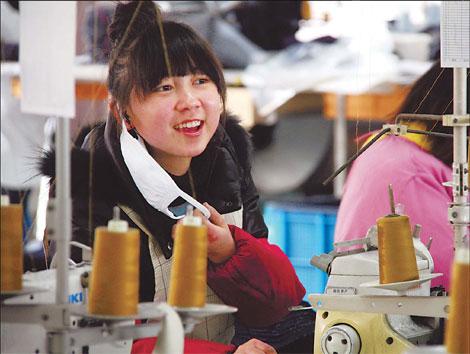
Migrant workers, like this woman working in a textile factory in Jiangsu province, are improving their prospects and slowly joining the ranks of the urban middle class. Xu Ruiping For China Daily
Leslie T Chang's Factory Girls illustrates the profound changes in China since reform and opening up through the eyes of migrant women workers. Chitralekha Basu interviews the author
Post Spring Festival there was a shortfall of workers at factories in the Yangtze and Pearl River Delta of more than 2 million, according to some estimates.
"Every time China goes through an economic shift, there is a heightened sense of alarm and exaggerated declarations in the press that the Chinese manufacturing system is no longer sustainable," says Leslie T Chang. "But Chinese companies and Chinese workers are flexible and quick to adapt to changing circumstances, and they will do so again."
The resilience that seems generic to the Chinese worker is celebrated in Chang's book, Factory Girls, which follows the stories of a few migrant women workers in the ruthless and chaotic industrial township of Dongguan, Guangdong province.
Since its publication in 2008 (an updated version came out in 2009) the book has been hailed as a seminal document of contemporary Chinese social history.
The author feels Chinese migrant workers - a 120-million-strong force which fortifies the country's robust economic system - are far more tenacious than a few media stories predicting the collapse of the institution would have us believe.
"In 2008, it was: Workers but no jobs, Dongguan is finished! In 2010: Jobs but no workers, Dongguan is finished!" Chang says, debunking the ideas.
Chang now lives in a quiet, small town in southwestern Colorado - several thousand miles away from the over-populated town of Dongguan, where she lived for two years - researching the archaeology of thousand-year-old ruins in the 19th century American southwest.
"That's a theme that ties back to Factory Girls," she says, "exploring how people see their own history and what meaning they find in it."
The story of how Chang connected with and, inevitably, lost several young women migrant workers in Dongguan, till she found her two characters - Lu Qingmin and Wu Chunming - is a fascinating read.
As a Beijing-based American-Chinese reporter with The Wall Street Journal she had filed several stories about migrant workers since 1999. It was fellow journalist Peter Hessler who told her there might be a book in the material she had begun collecting.
Hessler, a non-fiction writer and one of the foremost commentators on modern Chinese society, was the sounding board against whom Chang could bounce her ideas. It was Hessler who urged the deadline-driven Chang to take her time over a story - "to let the story develop naturally, to follow leads without knowing where they would go".
They married when she was about to wrap up the book.
Factory Girls picked up a series of awards, including the 2009 Asian American Literary Award For Nonfiction, the PEN USA Literary Award for Research Nonfiction and A New York Times Notable Book of 2008 prize.
"I believe the massive migration currently under way could prove to be the most important historical event in China of this era," Chang says. "Journalists and the public tend to focus their attention on day-to-day political events, but in the long view, this move to the city that has transformed hundreds of millions of individual lives may be far more important."
The two lead players in Chang's book have gone places too. The feisty and pragmatic Lu Qingmin, who started off on the factory floor as a 16 year old, talked her way into a clerk's job, nearly got tricked into prostitution, did a purchasing job in a hardware factory, saved enough money to buy her parents an apartment in the town near their village, and a secondhand Buick for herself.





